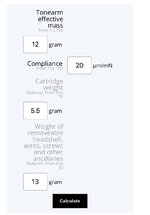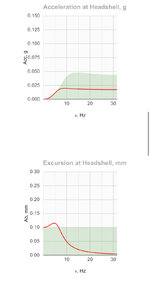Angsty
Well-Known Member
One down - three to go! It was an aluminum cantilever - I wanted to blame "the housekeeper"!I don’t think the material will make a big difference. I’ve damaged 4 cantilevers in 40 plus years. 3 were aluminum, one was boron.
One down - three to go! It was an aluminum cantilever - I wanted to blame "the housekeeper"!I don’t think the material will make a big difference. I’ve damaged 4 cantilevers in 40 plus years. 3 were aluminum, one was boron.
Every time I drop the needle off the edge of the record I blame the housekeeper.One down - three to go! It was an aluminum cantilever - I wanted to blame "the housekeeper"!
I have a P77i, but only one stylus. It will be the last cartridge for me, when I'm on the final stretch.That Garrett Brothers P77i looks interesting……
Depending on phono stage and wiring, you might want to consider the A/T 540ML.Back to researching and re-discovered Vessel - had forgotten about them. The A3SE was well-received on its introduction, but I have my eye on the AS3V instead, with a nude line contact stylus. I've had good success with line contact styli in the past, but in MC cartridges.
Anyone have an opinion on the Vessel AS3V based on use? Starting to get the itch to move off the Ortofon 2M Blue to something more engaging.
Someone on Reddit suggested a Grace F9 and I’d be lying if I said I hadn’t considered it.Depending on phono stage and wiring, you might want to consider the A/T 540ML.
Of course Grace is long out of business but you can get custom replacement styli from Soundsmith.Someone on Reddit suggested a Grace F9 and I’d be lying if I said I hadn’t considered it.
Yep, though they were apparently one-time manufacture. That said, an F9 cartridge sans stylus is not *terribly* expensive. It would be a very interesting option for while the Soundsmith is being rebuilt, and it seems to be a good compliance match for the MoFi.Of course Grace is long out of business but you can get custom replacement styli from Soundsmith.
Interesting to learn that the Garrott Bros., the Vessel, Shelter 201 and the Sumiko Pearl all have the same basis on a design from Excel Sound, the company who makes Hana cartridges.Back to researching and re-discovered Vessel - had forgotten about them. The A3SE was well-received on its introduction, but I have my eye on the AS3V instead, with a nude line contact stylus. I've had good success with line contact styli in the past, but in MC cartridges.
Anyone have an opinion on the Vessel AS3V based on use? Starting to get the itch to move off the Ortofon 2M Blue to something more engaging.
I’m starting to think a lot of the info generally used today regarding arm/cartridge matching is irrelevant. You might want to check the Korf Compliance calculator. I’ve found a fair bit of difference between accepted norms on paper vs. real life experience. The Korf appears to be far more representative of real life results.Yep, though they were apparently one-time manufacture. That said, an F9 cartridge sans stylus is not *terribly* expensive. It would be a very interesting option for while the Soundsmith is being rebuilt, and it seems to be a good compliance match for the MoFi.
I think this just talked me out of the Garrott Brothers. The Sumiko Pearl isn’t anything to brag about and the only thing good about the $99 Vessel is the price. Yes, the Vessel can be upgraded with a different stylus, but at $230 and up, I think I’d stick with safer bets.Interesting to learn that the Garrott Bros., the Vessel, Shelter 201 and the Sumiko Pearl all have the same basis on a design from Excel Sound, the company who makes Hana cartridges.
How should one determine the compliance number to input?I’m starting to think a lot of the info generally used today regarding arm/cartridge matching is irrelevant. You might want to check the Korf Compliance calculator. I’ve found a fair bit of difference between accepted norms on paper vs. real life experience. The Korf appears to be far more representative of real life results.
Examples:
Both the Grado Gold 2/3 and the IPT RigB500 (A/T 540ML) worked great on the MoFi. The Grado in particular should have been a disaster. It wasn’t. Hell, MoFis own cartridges are a bad match to their own turntables according to the graphs. On paper, Soundsmith, Hana, Denon 103/103R and Ortofon Quintets look good for the MoFis. You have far more suitable choices than the graphs would have you believe.
On the Technics GR, I’ve seen it said that Grados are at the edge of suitability. The Gold3 works fine, but I’ll admit it’s even better with fluid damping.
Compliance/Effective Mass Calculator
It should be in the cartridge manufacturer’s published specs.How should one determine the compliance number to input?
Japanese Compliance spec is not useful
5 x 10-3 m/N (Using a 100 Hz record)
I think I found a lateral spec online at 13 from Paul Miller's site.
Does this look correct?View attachment 137034


It cut off y axis on the graph.Looks correct, but looks like your acceleration at the headshell is close to the limit. Here’s mine with a Grado.
View attachment 137035View attachment 137036
Japanese Compliance spec is not useful
5 x 10-3 m/N (Using a 100 Hz record)
I think I found a lateral spec online at 13 from Paul Miller's site.
Does this look correct?View attachment 137034
That is the copy, paste spec from Denon on a DL-103R.Which cart / tonearm is this? Usually Japanese dynamic compliance is listed in x10-6 m/n? Converting to Eastern compliance for Western calculators (cu or um/nm same thing) is a shot in the dark without proper measurements. Not sure if the 13cu measure you reference is calculated by independent testing, if so that would be the best cu value to insert into the calculator.
Honestly I wouldn’t stress it. Looks like you have a medium mass arm that should mate with most carts on the market. Unless the res fq is dangerously low, not a major issue. Headshell weight can be used to optimize.
Duh, I should have remembered Denon likes an even weirder stat from my time with the 110. Yeah that should work for the formula then, Miller is obviously a legit test site. Still technically two assumed values into the formula, that’s the reason I don’t really like these calculators, they present themselves an an empirical solution but you’re honestly better off with your ears and eyes as soon as you start dealing with Japanese carts.That is the copy, paste spec from Denon on a DL-103R.
The tonearm is stock for the DP-300F (Denon does not give a mass spec); 13.5 seems to be regularly used on various forums.
13cu (lateral) was calculated by Miller audio. It looks like they did calculations for several carts and that report is floating around on the internet.
I think the problem becomes that when you're new to this hobby, you don't know exactly what a "bad match" sounds like. Calculators are a substitute for that kind of experience, but it does invite for more individual testing to deliberately create a bad match and hear the consequences.Duh, I should have remembered Denon likes an even weirder stat from my time with the 110. Yeah that should work for the formula then, Miller is obviously a legit test site. Still technically two assumed values into the formula, that’s the reason I don’t really like these calculators, they present themselves an an empirical solution but you’re honestly better off with your ears and eyes as soon as you start dealing with Japanese carts.
For a more accurate result you should add headshell and mounting hardware weight (you can weigh the whole assembly and subtract the cart weight spec). But another easier way is to spectrum analyze a quick and dirty needle drop and look for a resonance peak in the neighborhood of what the formula told you. No need for test records. But just with the Miller stat we can guess you’re in the “green zone” with that tonearm. I’m usually pretty insistent on objectivity in the hobby but these calculators have lead me to more confusion than help over the years haha. You usually know if you have a bad match just by seeing the cart track.